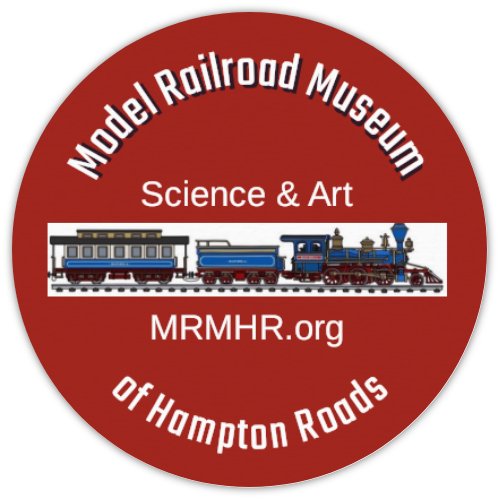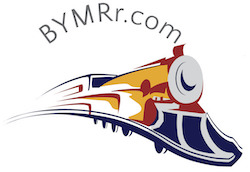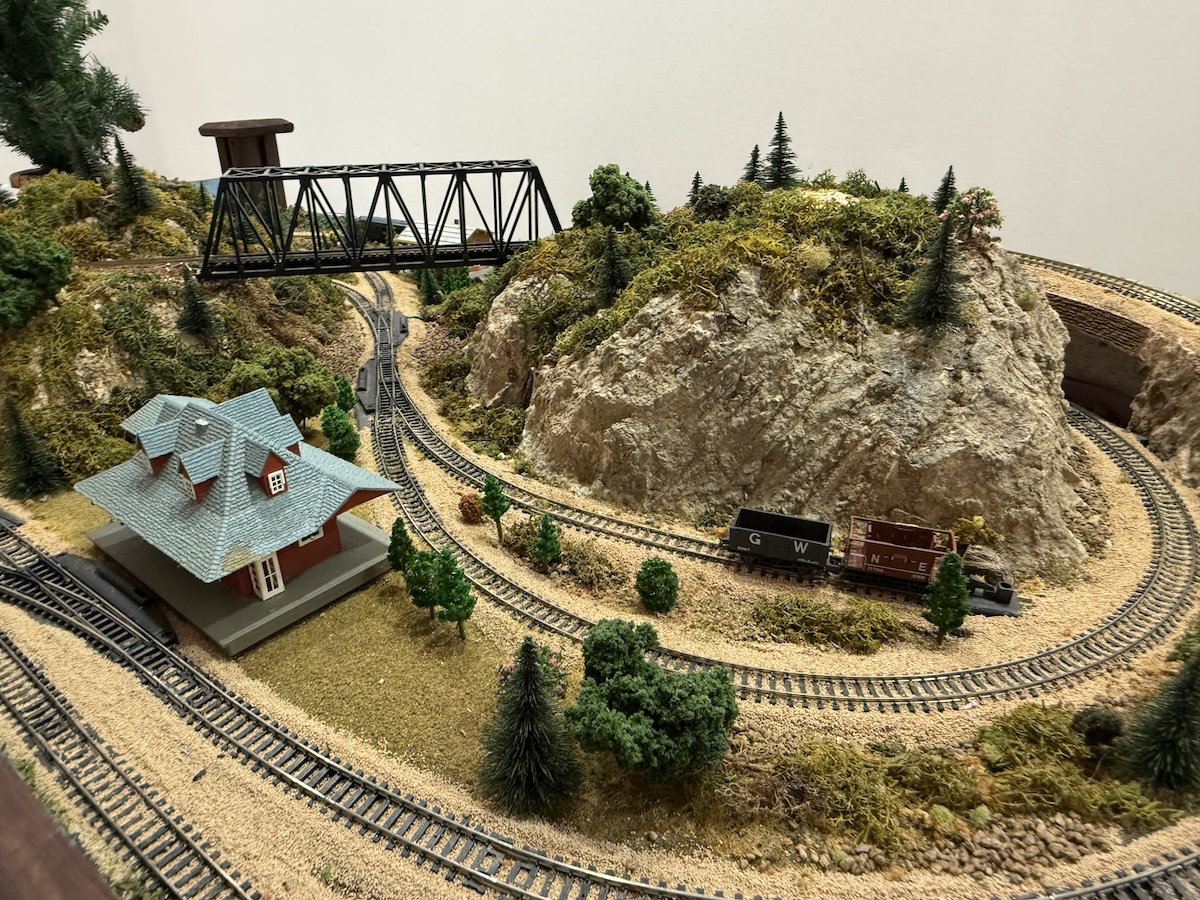Making Tracks
May 2024
Are you a Model Railroader?
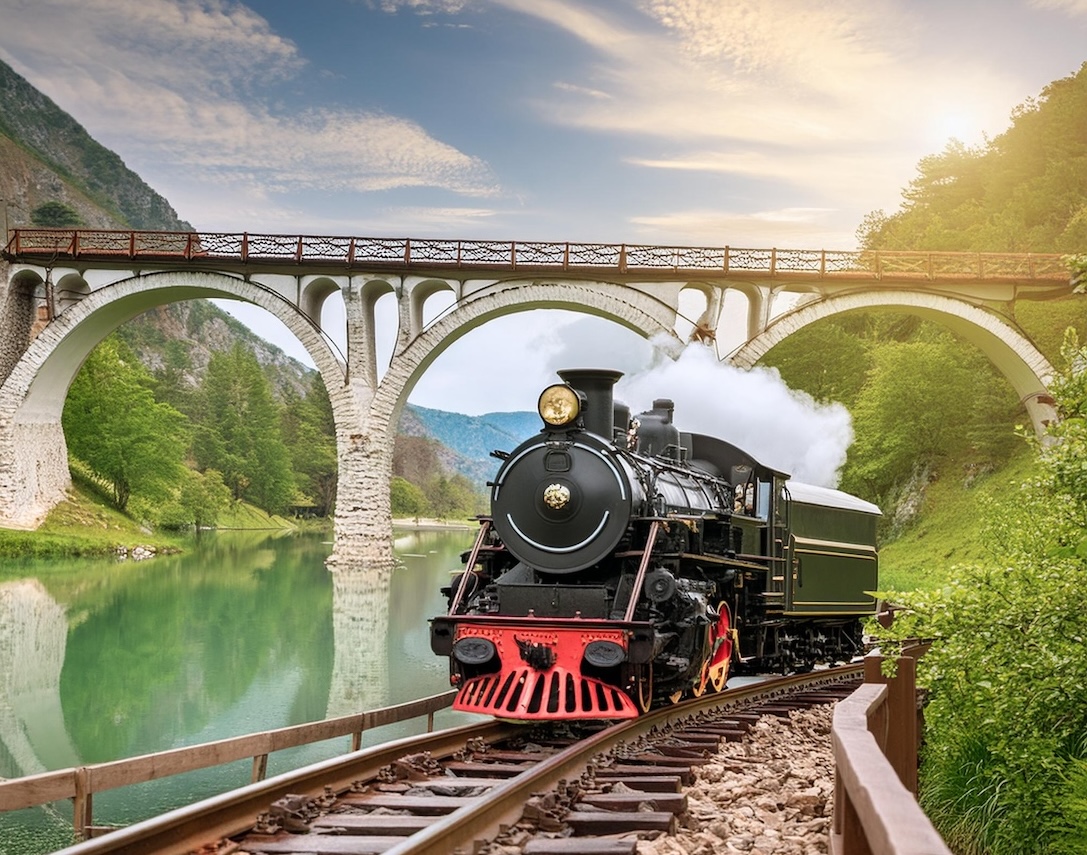 Train and Bridge over Creek: Adobe Firefly Generated image
Train and Bridge over Creek: Adobe Firefly Generated imageFundraising for the Museum
We continue the hard work of fundraising for the Museum, applying for grants, sponsorships and other resources. It is a slow process but as we've said before, giving up on it is not an option. Our vision is that this will be a wonderful place to visit for children of all ages. We will demonstrate history in this area in a way that it has never been done before. It will be a STEM learning center to stimulate knowledge on how science, technology, engineering and math can be used to solve problems and how to integrate these disciplines with art, people and culture. We aim to foster new careers, create new ideas and have fun while we're doing it. We will get there and we appreciate your support in the process. Thank you.
Birth of Virginia Beach:
Marshall Parks, Jr. -
Father of Inland Navigation, Part 2
Part 10 in a Series by Warren Leister, Historian
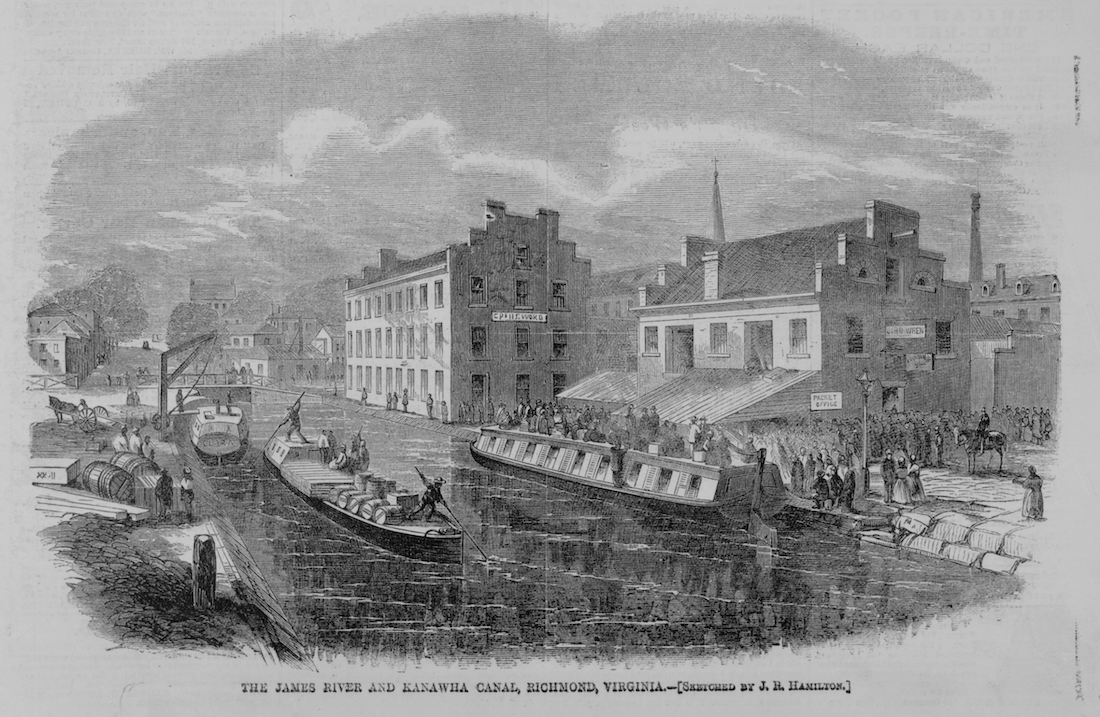 The attached artistic graphic created in 1865 is of the eastern end of the James River and Kanawha Canal in Richmond, Va. This canal was envisioned to be built as a key part of the Central Water Line through Virginia and West Virginia that as designed would eventually connect to the Ohio River. Ultimately, it was never completed as railroads took precedence and replaced any need for it at lower cost. In the end, railroads won the transportation battle against canals and inland canal building came to an end. Coastal canal building of short canals however continued and they became part of what is know today as the intercoastal waterway.
The attached artistic graphic created in 1865 is of the eastern end of the James River and Kanawha Canal in Richmond, Va. This canal was envisioned to be built as a key part of the Central Water Line through Virginia and West Virginia that as designed would eventually connect to the Ohio River. Ultimately, it was never completed as railroads took precedence and replaced any need for it at lower cost. In the end, railroads won the transportation battle against canals and inland canal building came to an end. Coastal canal building of short canals however continued and they became part of what is know today as the intercoastal waterway.“I am not one of those who contend that canal navigation is superior to rail. I am free to confess that if DeWitt Clinton {Clinton was the seventh New York Governor and was largely responsible for the construction of the Erie canal in upstate New York a major achievement of it’s time that connected the Atlantic Ocean with the Great Lakes and accelerated America’s westward expansion} had constructed his canal twenty years later it would have been a great failure. It must be recollected that when the Erie canal was opened, there was no established line of railway to compete for the trade of the Great West. He had only the ordinary {animal drawn} wagon to compete with, and hence the boats of the Erie canal, towed by horses, and carrying only 70 tons, were a great success. In the progress of the time, railways were constructed parallel to the canal, and the Legislature of New York had to enact laws to prevent ruinous competition, and it was necessary to enlarge the canal to three-fold its original capacity. Still later it has been found necessary to introduce stream upon it; and as the limited size of its locks have prevented the profitable use of steam, it has been lately decided to double the length of the locks to obviate that difficulty.”
“On the Albemarle and Chesapeake canal,
the first canal in this country having no tow-path, on which steam is used
exclusively for transportation and towing, it has been found that it is better
not to have tow-path, and to let the banks of the canal, where soil is
suitable, grow up in brier berries, bushes, trees, etc, etc that will preserve
the banks of the canal from abrasion {another word for erosion caused by
rain fall and the lapping water of the canal which may also be tidal in some
locations}. Should this system be adopted in the construction of the
Virginia water line {this was a localized name in Virginia for the portion
of the overall envisioned ‘Central Water Line’ through Virginia and West
Virginia to the Ohio river}, steamers carrying six hundred tons and upwards
may load on any of the Western rivers, and reach the tide water {at Hampton
Roads} of the Atlantic.”
Marshall Jr. continues that Colonel
William P. Craighill U. S. Army, who is in charge of the Central Water Line
project for the War Department, made a successful set of surveys and in a
report verified the feasibility of the best projected route with the shortest
proposed canals. He further states “When this line is completed steamers of
from 600 to 1,000 tons may load on any of the Western rivers, and reach the
Atlantic coast, and deposit their cargoes at Richmond, Norfolk, Philadelphia or
New York without breaking bulk {a reference whereby the cargo doesn’t have
to be manually unloaded and then reloaded from canal steamer to other
conveyances such as either an ocean going ship hold or a railroad car or animal
drawn wagons requiring much time and resources to accomplish}, going inland
route the entire way.”
“When that day shall arrive, and I have
great faith that the time is not far distant …, the surplus products of the
Great West may find a ready sale in the markets of the Old World {Europe},
which they may reach by a shorter line, and in less time than by New Orleans {via
the Mississippi River and its tributaries}.” “Very Respectfully, Marshall
Parks” {The Central Water Line project designed to connect the Ohio River to
the Virginia capes by utilizing existing rivers and waterways, while some
elements of this project were built early on, ultimately the parallel evolution
of railroads, in particular the Norfolk & Western, the Chesapeake &
Ohio, and the Baltimore & Ohio railroads rendered this project obsolete in
terms and of cost/efficiency versus effectiveness. After this time period,
railroads evolved to ultimately win the transportation war over water borne
craft on rivers and canals, at least in inland areas of the continental U. S.,
though obviously there remain exceptions such as ferries.}
From the Norfolk Virginian dated
October 24, 1873 a report titled “Great Virginia Water Line {this was also a
term used for the Central Water Line},” “The United States Senate Committee
on Internal Water Transportation were in session nearly all of the morning
yesterday and until a late hour last night in examining testimony as to the
practicability of the Great Virginia Water Line. Hon. Marshall Parks, of
Norfolk, was present during the examination. At an early hour this morning the
committee went up the canal to the first level, and on their return went
through Mr. Pace’s tobacco factory, with which they expressed themselves as
being greatly delighted. Afterwards they examined Hon. Mr. Bocock, Colonel
Craighill, engineer of the James river improvement; Colonel Whitcomb, chief
engineer of the Chesapeake and Ohio road; General Haupt. Of Richmond and
Atlanta Air Line; Colonel Carrington, of the James River and Kanawha canal;
Colonel Harris, chief engineer of the company; General Wickham, of the
Chesapeake and Ohio; Colonel Burwell ad I. D. Crenshaw, Esq., of this city {Norfolk},
and several others. All the experts agreed that the plan for building the
tunnel, which will be nine miles long, is a practicable one. And that it will
cost about fourteen million dollars {this would be equivalent to about 350
million in today’s dollars}. The committee will go west this evening by the
Chesapeake & Ohio road.” {expensive risky canal projects like this
further inland involving tunneling through ground of higher elevations were
virtually of last resort by this time-frame in places where railroads were
rapidly replacing canals at lower cost, so it’s doubtful that this project
evolved any further along then this. What’s interesting to note is the splendid
engineering group of men that Marshall Jr. was with as a part of this national
committee saying a great deal about the high esteem he was held in regard on
Capital Hill in Washington D. C. which says a lot about Marshall Jr. and his
national stature post Civil War especially in the area of transportation and
canal building. Only a very few fairly short canal tunnels were ever built in
the U. S. in Pennsylvania and Ohio at the high water mark of canal building pre
Civil War, though there are other canal tunnels in France including the longest
one in the world which is about four and half miles long, obviously shorter
than the nine mile long tunnel contemplated on this Virginia project, that Rove
tunnel which was in between Marseille and the Rhône river began
construction in 1906 and took 20 years to build and then ceased operation in
1963 when the roof of the tunnel in one section collapsed dumping material into
the canal}
By this time in his life, Marshall
Jr. has become such an important figure over the course of his life in the
realm of water borne transportation that among other things he is considered
the father of inland navigation. He promoted it every chance he could,
collaborated/conferred with government officials, and developed and maintained
detailed maps and plans over decades. Across the country and the world those in
the know, knew of him and readily sought him out.
End of Part 10
This concludes “Birth of Virginia Beach Part 10” the next installment,
Part 11, will be published in June, 2024.
History of Hampton Roads as a Major Transportation Center
Hampton Roads, in Southeastern Virginia, has a rich history as a transportation center dating back to colonial times. Here's a brief overview:
- Colonial Era: Hampton Roads was a crucial transportation hub even in the colonial era. Its deep natural harbor made it an important port for ships trading goods between the American colonies and Europe. Settlements like Jamestown and Williamsburg relied on Hampton Roads for trade and communication.
- Revolutionary War: During the Revolutionary War, Hampton Roads played a significant role as a strategic port for both the British and American forces. Control of the harbor was crucial for supplying troops and maintaining communication.
- 19th Century: Development of Ports and Railways: In the 19th century, the importance of Hampton Roads as a transportation center grew with the development of steam-powered ships and railways. Norfolk emerged as a major port city, serving as a gateway for goods traveling to and from the Midwest through the Ohio and Mississippi Rivers. The completion of the Dismal Swamp Canal in 1805 and later the Chesapeake and Ohio Canal in 1828 further enhanced the region's transportation network.
- Civil War: During the Civil War, Hampton Roads gained global attention with the famous naval battle between the ironclads USS Monitor and CSS Virginia (formerly USS Merrimack) in 1862. This battle marked a turning point in naval warfare and highlighted the region's strategic importance.
- 20th Century: Naval Expansion and Infrastructure Development: The 20th century saw further development of Hampton Roads as a transportation center, particularly with the expansion of naval facilities. Norfolk Naval Shipyard and Naval Station Norfolk became crucial hubs for the U.S. Navy, solidifying the region's role in maritime transportation and defense.
- Modern Era: Ports and Airports: Today, Hampton Roads remains a vital transportation center with several major ports, including the Port of Virginia, one of the busiest ports on the East Coast. Norfolk International Airport serves as a major air transportation hub for the region, connecting it to domestic and international destinations.
Overall, Hampton Roads' history as a transportation center is deeply intertwined with the economic, military, and cultural development of the region, making it a crucial hub for trade, commerce, and defense.
This history gives us a tremendous opportunity to model, display and demonstrate all of these eras and to show others how Hampton Roads led the way in the use of trains and waterways to expand commerce and trade from a major port to the rest of the country.
Thank you for reading our newsletter, Making Tracks, and for your interest in the development of the historical Model Railroad Museum to be established here in Hampton Roads in the near future. Please consider a donation or sponsorship of this future attraction to help us acquire a proper location.
Get Updates and Special Offers in
the MRMHR Newsletter:
Making Tracks
Sign Up Here...
The official newsletter for the Model Railroad Museum of Hampton Roads.
Share this site on your favorite Social Media page!
Recent Articles
-
Making Tracks April 2025
Apr 05, 25 11:10 AM
Official newsletter of the Model Railroad Museum of Hampton Roads containing news and updates about the museum and other stories of interest. -
Gift Shop
Mar 23, 25 08:19 AM
Want to buy a gift for a special person, We sell model trains and railroad-related gift items. We can order almost anything for you if it's available -
Model Railroad Advertising
Mar 03, 25 09:15 AM
Here is you chance to advertise your business to a selected audience of those who are truly interested in the hobby.
The Model Railroad Museum of Hampton Roads will be a fantastic community center based on running, operating and even building your own model railroads! There's something for every age here.
Learn about the real history of this area and how important it was in the building of America. Watch how railroads were built, the people involved, where America's roots were formed.
As they build their own railroads, students will be learning about science, electronics, architecture, technology, engineering, mathematics, and the art of 3 dimensional model landscaping. They can earn rewards for completing projects and winning contests.
Try to solve yardmaster problems on a switching layout like getting the lumber from the forest to the furniture store, by way of the saw mill and the lumber yard.
Run your train around blockades and other trains to get to the station on time without speeding or crashing.
Play railroad monopoly using model railroads. Winner is the one who can collect the most cars into his yard within an hour.
There will be programs for autistic and special needs kids, disabled adults and veterans.
School tours. Holiday Shows. Library and video rooms. Scouts are welcome. Even youngsters will have their own wooden models to enjoy. Classrooms and hands-on clinics for adults. Learn how to get started in the hobby. Or just enjoy the fun.
Everybody loves trains and this will prove it! Just click on the either the blue or the yellow DONATE button below to make it happen...
PayPal Giving Fund:
No Credit Card Fees
OR...
Charitable Donations through PayPal, Credit or Debit cards:
(Opt in or out of paying credit card fees)
Get Updates and Special Offers in
the MRMHR Newsletter:
Making Tracks
Sign Up Here...
The official newsletter for the Model Railroad Museum of Hampton Roads

